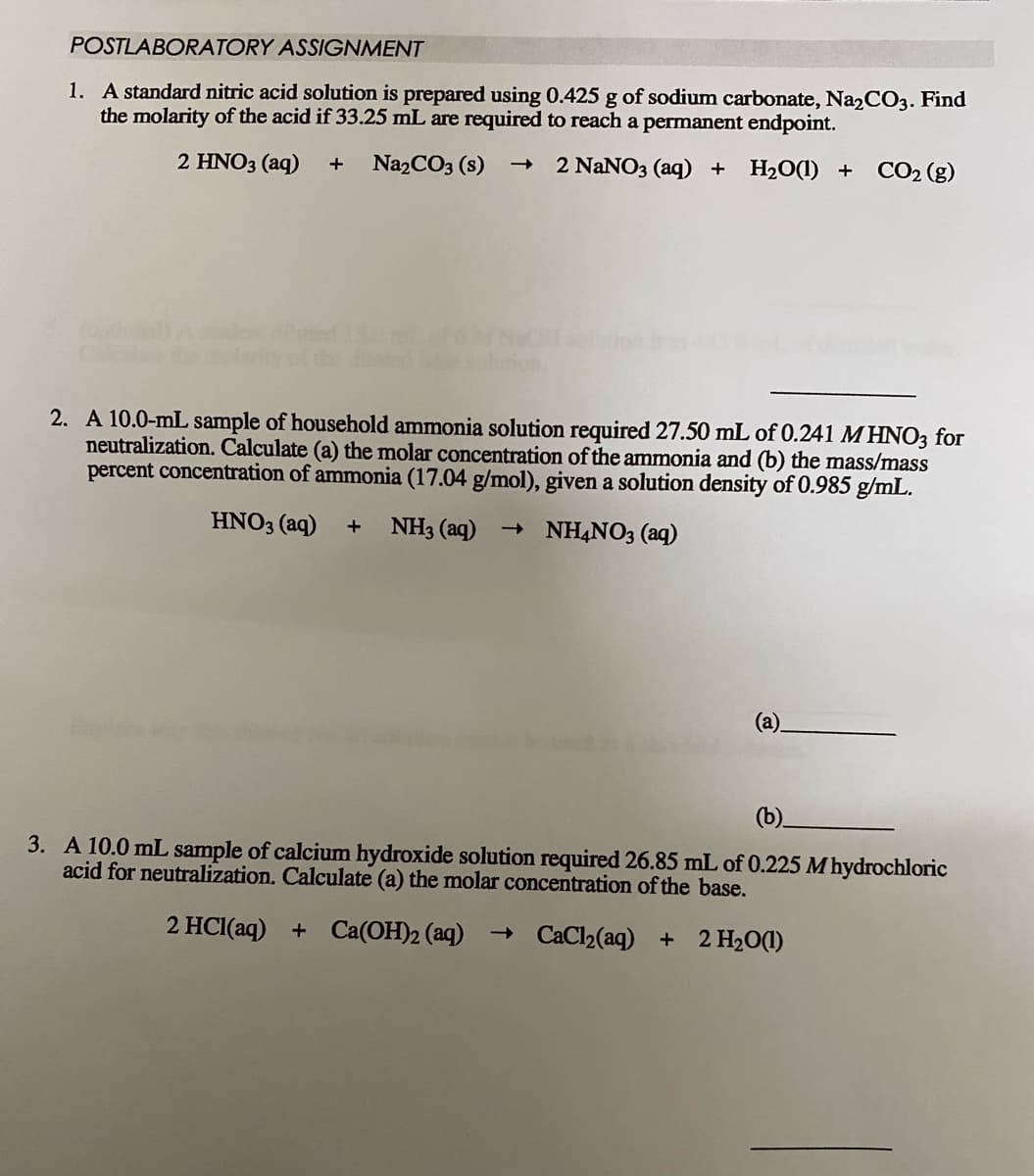1. A standard nitric acid solution is prepared using 0.425 g of sodium carbonate, Na2CO3. Find the molarity of the acid if 33.25 mL are required to reach a permanent endpoint. 2 HNO3(aq) + Na₂CO3 (s) → 2 NaNO3 (aq) + H₂O(1) + CO₂(g) 2. A 10.0-mL sample of household ammonia solution required 27.50 mL of 0.241 M HNO3 for neutralization. Calculate (a) the molar concentration of the ammonia and (b) the mass/mass percent concentration of ammonia (17.04 g/mol), given a solution density of 0.985 g/mL. HNO3(aq) + NH3 (aq) → NH4NO3(aq) (a). (b). A 10.0 mL sample of calcium hydroxide solution required 26.85 mL of 0.225 M hydrochloric acid for neutralization. Calculate (a) the molar concentration of the base. 2 HCl(aq) + Ca(OH)2 (aq) → CaCl₂(aq) + 2 H₂O(1)
1. A standard nitric acid solution is prepared using 0.425 g of sodium carbonate, Na2CO3. Find the molarity of the acid if 33.25 mL are required to reach a permanent endpoint. 2 HNO3(aq) + Na₂CO3 (s) → 2 NaNO3 (aq) + H₂O(1) + CO₂(g) 2. A 10.0-mL sample of household ammonia solution required 27.50 mL of 0.241 M HNO3 for neutralization. Calculate (a) the molar concentration of the ammonia and (b) the mass/mass percent concentration of ammonia (17.04 g/mol), given a solution density of 0.985 g/mL. HNO3(aq) + NH3 (aq) → NH4NO3(aq) (a). (b). A 10.0 mL sample of calcium hydroxide solution required 26.85 mL of 0.225 M hydrochloric acid for neutralization. Calculate (a) the molar concentration of the base. 2 HCl(aq) + Ca(OH)2 (aq) → CaCl₂(aq) + 2 H₂O(1)
Introductory Chemistry: A Foundation
9th Edition
ISBN:9781337399425
Author:Steven S. Zumdahl, Donald J. DeCoste
Publisher:Steven S. Zumdahl, Donald J. DeCoste
Chapter15: Solutions
Section: Chapter Questions
Problem 38CR
Related questions
Question
Need all 1,2,3

Transcribed Image Text:POSTLABORATORY ASSIGNMENT
1. A standard nitric acid solution is prepared using 0.425 g of sodium carbonate, Na2CO3. Find
the molarity of the acid if 33.25 mL are required to reach a permanent endpoint.
2 HNO3(aq) + Na2CO3 (s) → 2 NaNO3 (aq) + H₂O(1) + CO₂(g)
2. A 10.0-mL sample of household ammonia solution required 27.50 mL of 0.241 M HNO3 for
neutralization. Calculate (a) the molar concentration of the ammonia and (b) the mass/mass
percent concentration of ammonia (17.04 g/mol), given a solution density of 0.985 g/mL.
HNO3(aq) + NH3 (aq) → NH4NO3(aq)
(a).
(b)
3. A 10.0 mL sample of calcium hydroxide solution required 26.85 mL of 0.225 M hydrochloric
acid for neutralization. Calculate (a) the molar concentration of the base.
2 HCl(aq) + Ca(OH)2 (aq) → CaCl₂(aq) + 2 H₂O(1)
Expert Solution
This question has been solved!
Explore an expertly crafted, step-by-step solution for a thorough understanding of key concepts.
This is a popular solution!
Trending now
This is a popular solution!
Step by step
Solved in 5 steps with 5 images

Knowledge Booster
Learn more about
Need a deep-dive on the concept behind this application? Look no further. Learn more about this topic, chemistry and related others by exploring similar questions and additional content below.Recommended textbooks for you

Introductory Chemistry: A Foundation
Chemistry
ISBN:
9781337399425
Author:
Steven S. Zumdahl, Donald J. DeCoste
Publisher:
Cengage Learning

Chemistry: Principles and Reactions
Chemistry
ISBN:
9781305079373
Author:
William L. Masterton, Cecile N. Hurley
Publisher:
Cengage Learning

Chemistry: The Molecular Science
Chemistry
ISBN:
9781285199047
Author:
John W. Moore, Conrad L. Stanitski
Publisher:
Cengage Learning

Introductory Chemistry: A Foundation
Chemistry
ISBN:
9781337399425
Author:
Steven S. Zumdahl, Donald J. DeCoste
Publisher:
Cengage Learning

Chemistry: Principles and Reactions
Chemistry
ISBN:
9781305079373
Author:
William L. Masterton, Cecile N. Hurley
Publisher:
Cengage Learning

Chemistry: The Molecular Science
Chemistry
ISBN:
9781285199047
Author:
John W. Moore, Conrad L. Stanitski
Publisher:
Cengage Learning

Chemistry: Principles and Practice
Chemistry
ISBN:
9780534420123
Author:
Daniel L. Reger, Scott R. Goode, David W. Ball, Edward Mercer
Publisher:
Cengage Learning

Chemistry
Chemistry
ISBN:
9781305957404
Author:
Steven S. Zumdahl, Susan A. Zumdahl, Donald J. DeCoste
Publisher:
Cengage Learning

Chemistry & Chemical Reactivity
Chemistry
ISBN:
9781133949640
Author:
John C. Kotz, Paul M. Treichel, John Townsend, David Treichel
Publisher:
Cengage Learning